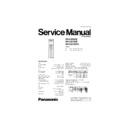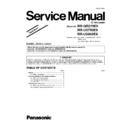Read Panasonic RR-US950E / RR-US750E / RR-US750PC Service Manual online
Power
Rechargeable Battery :
DC 1.2 V Ni-MH: 1 piece
Battery :
DC 1.5 V AAA LR03: 1 piece
Recharging spec. :
Only USB Recharge,
Recharging time: Approx. 2 hours
Audio
Sampling Frequency
(Stereo/Monaural):
(Stereo/Monaural):
XP: 44.1 kHz/44.1 kHz
LP: 22.05 kHz/16 kHz
EP: 11.025 kHz/8 kHz
Recording Format :
MP3
Playable Bit Rate (MUSIC folder) :
8 kbps to 320 kbps
Playable Sampling Frequency
(MUSIC folder) :
(MUSIC folder) :
8 kHz to 48 kHz
Frequency Response
(-10 dB, Rec-Play,Monaural) :
(-10 dB, Rec-Play,Monaural) :
XP: 180 Hz to 15,000 Hz
LP: 180 Hz to 6,200 Hz
EP: 180 Hz to 3,400 Hz
Built-in Microphone S/N Ratio :
40.5 dB (XP) Filter (JIS A)
Jack
USB :
USB2.0 (Hi-Speed)
Audio Output :
Earphone
ø3.5 mm (1/8 in.) jack, 16
Ω ,
Max. 3 mW
Speaker output
ø20 mm (25/32 in.) 8
Ω ,
Max. 50 mW
Built-in Memory
2 GB*
1
(For RR-US950)
1 GB*
1
(For RR-US750)
RR-US950E
RR-US750E
RR-US750PC
Colour
(S)..........Silver Type (RR-US750 only)
(K)..........Black Type (RR-US950 only)
(K)..........Black Type (RR-US950 only)
Operating Temperature
0°C to 40°C (32°F to 104°F)
Operating Humidity :
20% to 80% (non-condensing)
Rechargeable Temperature
5°C to 35°C (41°F to 95°F)
*1 GB means one billion bytes. Usable capacity will be less.
Battery life (may be less depending on the operating conditions.)
*2 Using recommended Panasonic Alkaline battery.
*3 When zoom microphone is off.
*4 When audio is output from speaker (Vol.: 13, EQ: off, playback
speed control : X1)
*3 When zoom microphone is off.
*4 When audio is output from speaker (Vol.: 13, EQ: off, playback
speed control : X1)
Standard recordable time
IC Recorder
Specification
ORDER NO. MD0803001CE
A1
Mass
Approx. 56.0 g (1.98 lb.) with
Battery
Approx. 44.0 g (1.55 lb.) without
Battery
Max. Dimensions (W H D)
33.6 mm 115.0 mm 17.6 mm
(1-5/16" 4-17/32" 11/16")
1
Safety Precautions
3
2
Prevention of Electro Static Discharge (ESD) to
Electrostatically Sensitive (ES) Devices
4
3
Handling the Lead-free Solder
5
4
Operating Procedures
6
5
Assembling and Disassembling
12
6
Service Fixture and Tools
24
7
Service Position
25
8
Voltage Measurement & Waveform Chart
26
Cabinet dimensions (W H D)
33.1 mm 115.0 mm 14.7 mm
(1-5/16" 4-17/32" 19/32")
Note :
1. Specifications are subject to change withiout notices.
1. Specifications are subject to change withiout notices.
9
Wiring Connection Diagram
28
10 Block Diagram
29
11 Notes Of Schematic Diagram
31
12 Schematic Diagram
33
13 Printed Circuit Board Diagram
41
14 Illustration of IC’s, Transistors and Diodes
43
15 Exploded Views
45
16 Replacement Parts List
47
CONTENTS
Page
Page
2
RR-US950E / RR-US750E / RR-US750PC
1 Safety Precautions
1.1. GENERAL GUIDELINES
1. When servicing, observe the original lead dress. If a short circuit is found, replace all parts which have been overheated or
damaged by the short circuit.
2. After servicing, see to it that all the protective devices such as insulation barriers, insulation papers shields are properly
installed.
3. After servicing, make the following leakage current checks to prevent the customer from being exposed to shock hazards.
1.2. Protection Circuitry
The protection circuitry may have operated if either of the following conditions are noticed:
• No sound is heard when the power is turned on.
• Stops during a performance.
The function of this circuitry is to prevent circuitry damage if, for example, the positive and negative speaker connection wires are
“shorted”, or if speaker systems with an impedance less than the indicated rated impedance of the amplifier are used.
• Stops during a performance.
The function of this circuitry is to prevent circuitry damage if, for example, the positive and negative speaker connection wires are
“shorted”, or if speaker systems with an impedance less than the indicated rated impedance of the amplifier are used.
If this occurs, follow the procedure outlines below:
1. Turn off the power.
2. Determine the cause of the problem and correct it.
3. Turn on the power once again after one minute.
Note:
When the protection circuitry functions, the unit will not operate unless the power is first turned off and then on again.
1.3. Safety Part Information
Safety Parts List:
There are special components used in this equipment which are important for safety.These parts are marked by
in the
Schematic Diagrams & Replacement Parts List. It is essential that these critical parts should be replaced with manufacturer’s
specified parts to prevent shock, fire or other hazards. Do not modify the original design without permission of manufacturer.
specified parts to prevent shock, fire or other hazards. Do not modify the original design without permission of manufacturer.
Table 1
Reference No.
Part No.
Part Name & Description
Remarks
ICP101
D4FB1R100015
RESETTABLE FUSE
[M]
ICP501
D4FB1R100015
RESETTABLE FUSE
[M]
3
RR-US950E / RR-US750E / RR-US750PC
2 Prevention of Electro Static Discharge (ESD) to
Electrostatically Sensitive (ES) Devices
Some semiconductor (solid state) devices can be damaged easily by electricity. Such components commonly are called
Electrostatically Sensitive (ES) Devices. Examples of typical ES devices are integrated circuits and some field-effect transistors and
semiconductor “chip” components. The following techniques should be used to help reduce the incidence of component damage
caused by electro static discharge (ESD).
Electrostatically Sensitive (ES) Devices. Examples of typical ES devices are integrated circuits and some field-effect transistors and
semiconductor “chip” components. The following techniques should be used to help reduce the incidence of component damage
caused by electro static discharge (ESD).
1. Immediately before handling any semiconductor component or semiconductor-equiped assembly, drain off any ESD on your
body by touching a known earth ground. Alternatively, obtain and wear a commercially available discharging ESD wrist strap,
which should be removed for potential shock reasons prior to applying power to the unit under test.
which should be removed for potential shock reasons prior to applying power to the unit under test.
2. After removing an electrical assembly equiped with ES devices, place the assembly on a conductive surface such as aluminium
foil, to prevent electrostatic charge build up or exposure of the assembly.
3. Use only a grounded-tip soldering iron to solder or unsolder ES devices.
4. Use only an anti-static solder removal device. Some solder removal devices not classified as “anti-static (ESD protected)” can
generate electrical charge to damage ES devices.
5. Do not use freon-propelled chemicals. These can generate electrical charges sufficient to damage ES devices.
6. Do not remove a replacement ES device from its protective package until immediately before you are ready to install it. (Most
replacement ES devices are packaged with leads electrically shorted together by conductive foam, aluminium foil or
comparable conductive material).
comparable conductive material).
7. Immediately before removing the protective material from the leads of a replacement ES device, touch the protective material
to the chassis or circuit assembly into which the device will be installed.
Caution
Be sure no power is applied to the chassis or circuit, and observe all other safety precautions.
8. Minimize bodily motions when handling unpackaged replacement ES devices. (Otherwise harmless motion such as the
brushing together of your clothes fabric or the lifting of your foot from a carpeted floor can generate static electricity (ESD)
sufficient to damage an ES device).
sufficient to damage an ES device).
4
RR-US950E / RR-US750E / RR-US750PC


